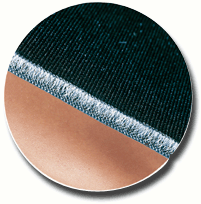The Militex Division of New York City-based Gehring Textiles Inc. has added five new constructions to D3, its line of open, three-dimensional spacer fabrics for various medical, sports and industrial uses. The new fabrics replace neoprene foam in sports-medicine applications. D3 fabrics can combine as many as three different fibers in each construction, exploiting the particular properties of each fiber in the facings and the spacer yarns between them. Cushioning, compression and recovery, breathability, insulation and other performance propertiescan be structurally integrated into one fabric, depending on the intended end-use.
D3 Construction
 In D3 spacer fabrics, two separate face fibers are combined with an inner spacer yarn or yarns in a warp-knitted construction. The spacer yarns contribute engineered properties such as thickness, elasticity, compression, and physical spaces and channels. The face fibers provide such qualities as density, water-repellency, antimicrobial attributes, softness, breathability, UV or chemical resistance, fire retardation and texture. A fabric can be antibacterial on one side, water-repellent on the other and impact-resistant in between. One face can be Velcro®-compatible or
In D3 spacer fabrics, two separate face fibers are combined with an inner spacer yarn or yarns in a warp-knitted construction. The spacer yarns contribute engineered properties such as thickness, elasticity, compression, and physical spaces and channels. The face fibers provide such qualities as density, water-repellency, antimicrobial attributes, softness, breathability, UV or chemical resistance, fire retardation and texture. A fabric can be antibacterial on one side, water-repellent on the other and impact-resistant in between. One face can be Velcro®-compatible orhave a mesh construction. Possible face fibers include spandex, Kevlar®, Nomex®, PBI®, monofilament, microdeniers and other performance fibers. The fabrics can be thick or thin, and the
thickness within a fabric can also vary across its width.
The manufacturing process, unlike that for most laminated fabrics, is environmentally friendly. Because the materials used in the fabrics are all homogenous and no glues are used, they can be recycled.
More Versatile Than Neoprene, And More Durable
D3 fabrics are more versatile than neoprene for sports-medicine applications, as well as being more durable, said Skip Gehring, vice president. The fabric structure allows greater control over such properties as elasticity. Neoprene stretches in all directions, but elasticity in D3 fabrics can be confined to one direction, or the degree of stretch in various directions can be controlled to allow more in one direction than in another. Impact resistance can be incorporated
into the fabric without affecting elasticity or thickness.
As for durability, although neoprene is washable, repeated launderings cause it to dry out and lose its stretch and compression properties. D3 fabrics retain their qualities even after repeated washings.
Other advantages of D3 over neoprene include breathability, as well as the ability to control heat and moisture transfer. For medical applications, such qualities, along with improved elasticity, promote healing.
Gehring said the company will also custom-engineer fabrics to meet specific end-use requirements. The warp-knitted patterns possible are almost limitless.
April 2001




